

Catch Fish with
Mike Ladle
Information Page
SEA FISHING
For anyone unfamiliar with the site always check the FRESHWATER, SALTWATER and TACK-TICS pages. The Saltwater page now extends back as a record of over several years of (mostly) sea fishing and may be a useful guide as to when to fish. The Freshwater stuff is also up to date now. I keep adding to both. These pages are effectively my diary and the latest will usually be about fishing in the previous day or two. As you see I also add the odd piece from my friends and correspondents if I've not been doing much. The Tactics pages which are chiefly 'how I do it' plus a bit of science are also updated regularly and (I think) worth a read (the earlier ones are mostly tackle and 'how to do it' stuff).
'Success with bait - at last!'
My original experiments with free-lined baits for the local bass took place a few years ago and at the time were a revelation to me. I've tried the tactics a few times since, often with limited success, but I suspect that the approach may be worth a concentrated effort. Let me just remind myself of why I used to be so keen and why I have not done much recently. In truth I'm just as susceptible to envy as anyone so, when I see my pals hauling out bass on lures I want a share of the action. However, after a lifetime spent fishing I realise that success can be elusive even if you know what you are doing. Quite often it may be necessary to put up with a few (or many) blanks if you are to succeed, particularly when you are trying out unusual tactics.
I'll outline exactly what I'm talking about. Success, with free-lined bait tactics, depends, as always, on having confidence. Firstly, and most important, remember that bass - including some large ones - will often feed in VERY SHALLOW WATER, perhaps as little as 30cm deep and, despite the fact that their backs may be just sub-surface, you may not see them or know that they are there. Secondly, Although I've written over the years that big bass like rough ground, weed, strong currents and turbulence. They can regularly be caught from more or less bare rock or sand even when it's flat calm and gin clear, so not traditionally "bassy". In fact the exact opposite. Since places like this are often unfished by those 'in the know', you could be on a winner if you try them. Thirdly, you need peace and quiet. Fishing alone, early morning or late evening, is probably best and, for sure, you don't want anyone (including yourself) spinning or fly fishing and waving their arms about near your chosen spot. Bass are just as wary as any other species of fish, so don't move around or shine lights on the water. Lastly, it isn't necessary to use them but I'm keen on circle hooks (see my Tack-Tics page 520). I've been using them for years and I'm now at the stage where I am totally sure that these gadgets ARE EFFECTIVE if you use them correctly. They DO hook fish well and they DO cause minimal damage to the fish caught on them. Of course, you will miss a few bites but that happens with every type of hook. So, if you try them, be prepared, on occasion, for missed runs and don't let it put you off.
Firstly a couple of examples from my last two trips, neither session's actual fishing time lasted much more than an hour. Having blanked one evening the previous week - when I went with my pal Martyn, really just for us to wet a line and have a chat - I decided to give my next trip some thought. Another pal Bill had told me, after his recent lure-fishing trip, that he'd seen (but not caught) a decent bass in a spot where I'd been successful with bait before. He even told me the time (=state of tide) and predicted when the fish might turn up. Well, information like that is too good to ignore: so at 04:20 I was trudging along the rocks towards the appointed place. When I arrived the sky was already beginning to lighten so I searched for the exact rock formation that Bill had mentioned, put down the bag, shoved my big, well-sharpened, circle hook twice through the thin end of the mackerel fillet and walked across the flat rocks, with their thin felt of furry algae, towards the water's edge.
It was low tide and there was no breeze so the sea was like glass. With a gentle, under-arm swing I flicked the bait out a few metres into ankle deep water, tightened the line a bit so I could just feel the bait, and waited. To pass the time I watched a small rock sticking just above the surface to see if the tide was beginning to flood. Ten minutes passed as I stood holding the rod with the line between the fingers of my left hand. Was that a swirl? I wasn't sure. Impatience got the better of me and I reeled in to check whether the bait might have been crabbed or shrimped - it was still in mint condition. I cast again, this time it fell a couple of metres to the right of where it had been the first time. After a few minutes I saw a definite little swirl not far from where I stood. I switched into 'hopefully alert mode'. The line twitched and then nothing, I decided that it must have been a blenny. I waited. My rock was now almost covered so the water had risen perhaps three or four centimetres. Another slight swirtl disturbed the surface, so there were definitely fish about. Five more minutes passed and once more my patience was getting thin. I'd better reel in again just to check on the bait (the 'blenny' might have damaged it). I closed the bale and slowly turned the handle of the reel. The bow in the braided line tightened and something felt heavy. There was a big splash within a few cm of the advancing sea's edge, the rod bowed and I was in! The fish went berserk, rushing away with the clutch buzzing loudly. Two or three times it did the same thing causing a bow wave as it ploughed through the shallow water, tail thrashing. It seemed well hooked so I slowly walked backwards drawing the bass towards the edge. It slid ashore and I had it! Eureka! To be honest it was a bit of a disappointment as, despite the fight, I could see it was no monster. I took a couple of pictures, removed the hook and measured the fork length of the fish - only 53cm, probably about 3.5lb, one of my smallest ever on a big bait, but so welcome. I slid it back into the sea and away it swam.
Not a bad bass for starters.
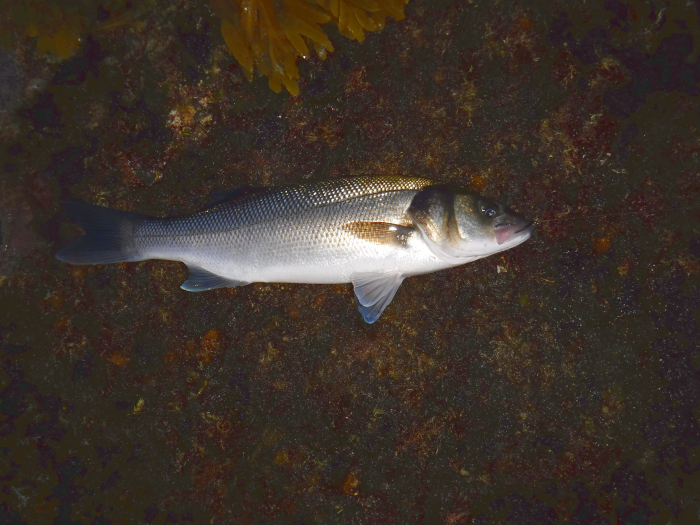
Typically a well embedded circle hook in the scissors. Such fish are easy to unhook and release.
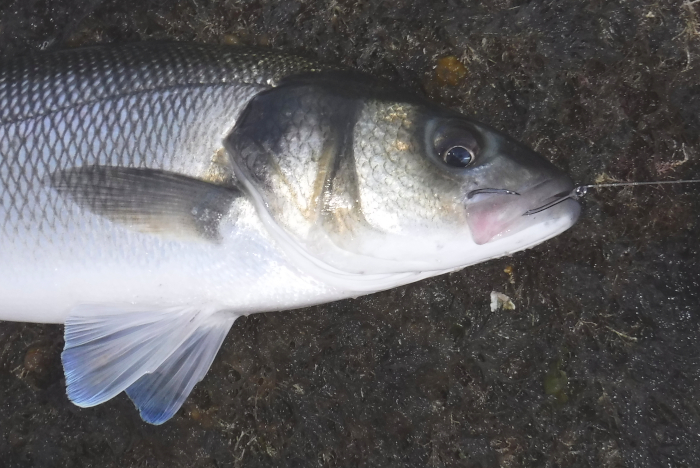
After my success I decided to try the same tactics again the following morning. This time I opted to go to a spot about a couple of miles from where I'd caught 'Bill's bass'. Again it was a spot where I knew that bass came in to forage over bare, flat rock. When I arrived on the shore I found that conditions had changed. Of course it was low tide and the water was still clear but now the sky was grey and overcast and there was a stiff breeze blwing and causing a sharp chop on the water surface. Now the wind can be a nusance when you are free-lining because the drag on your line may shift the bait from where you intended. However, this time, the wind was behind me and it was still easy fishing. I baited up with a fillet of mackerel, as before, settled my bum on a handy boulder and flicked the baited hook out to lie on the bare shale in shallow water.
I looked at my watch - it was 04:55 - just past low water. My bait lay in the gap between two large boulders. From where I sat, light reflecting from the water surface meant that I couldn't see the bait, even though it was close by. I felt a sharp tug and instinctively released my grip on the braid. Line began to trickle out, there was a brief pause then off it went again. Now it was accelerating into a proper bass run. I let it take another 10m or so of line before pulling an armful of slack line from the spool and, before it could tighten up, flicking over the bale arm. The line drew tight, the rod pulled round and it was on. I played the fish for a while before sliding it ashore (easy when the rock is like a table top). It was a decent one, no monster but bigger than the one I'd had on the previous morning. On my tape it was 59cm fork length and in good condition so near 5lb.
Another nice, plump bass on free-lined mackerel fillet..
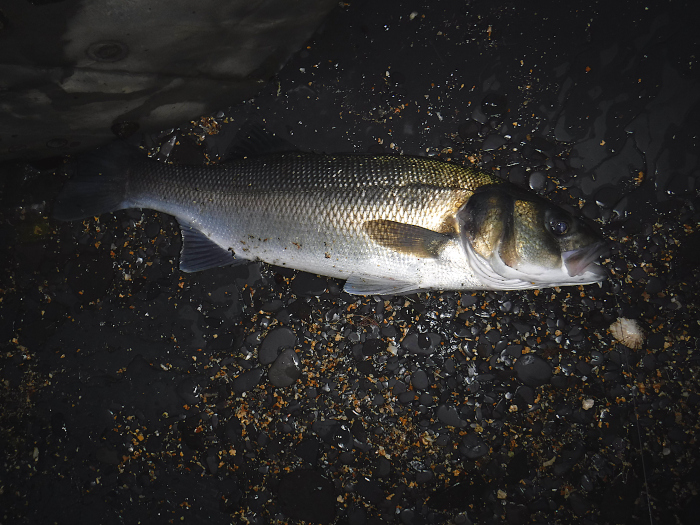
Despite appearances the large hook was just inside the mouth of the bass..
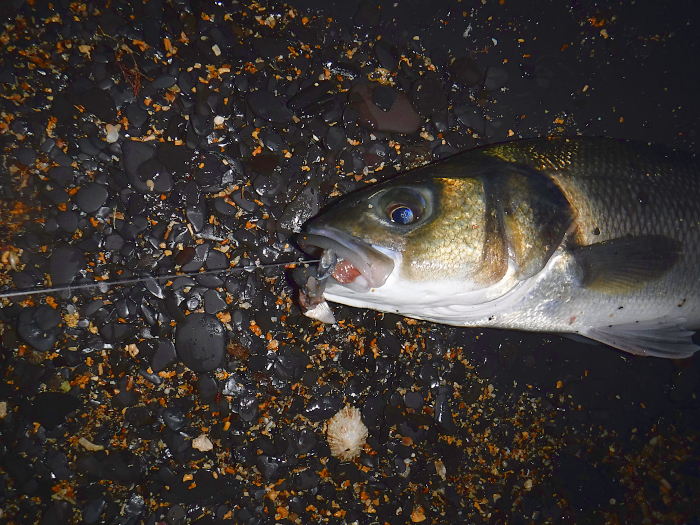
I did the honours with my little camera and after releasing the fish watch as it regained composure and slid away. Two bass in two short sessions. Thanks for the tip Bill. Just bear in mind Early flood; Calm Conditions; Bare, Flat Rock; Good Sized Hook/Bait; More Patience Than Me.
– PLEASE TELL YOUR TWITTER, FACEBOOK, EMAIL FRIENDS ABOUT THESE BOOKS.
THE SECOND WAVE

Written with Steve Pitts this is a SEQUEL TO THE BESTSELLER "Operation Sea Angler" IT'S AVAILABLE ON PAPER FROM -
HOOKED ON BASS
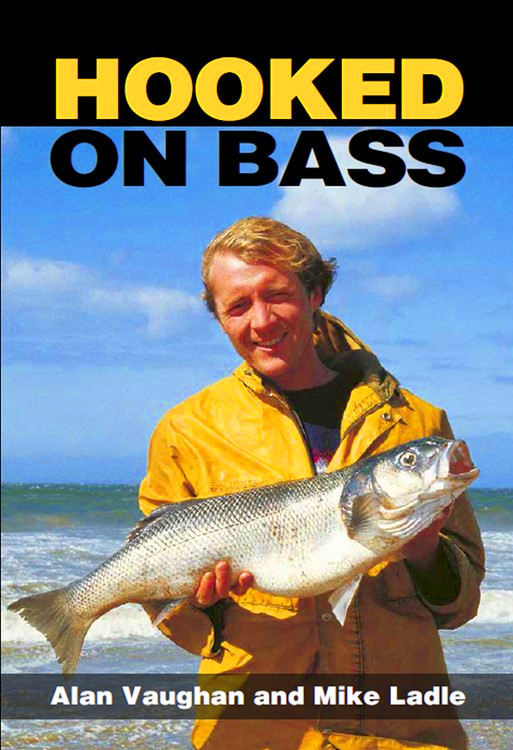
Written with Alan Vaughan. NEW PRINT OF THE ORIGINAL: IN PAPERBACK. Copies available from all good book shops RRP £14:99 -
ANGLING ON THE EDGE
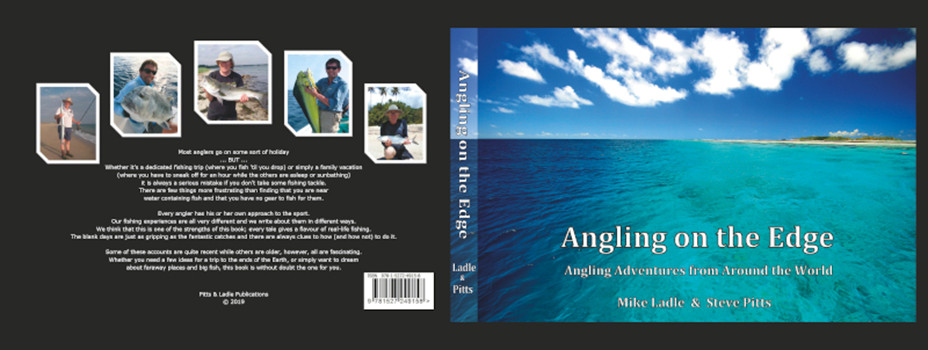
Copies can now be ordered (printed on demand) from Steve Pitts at £34.00, inc. Royal Mail Insured UK Mainland Postage.
To order a book send an E-MAIL to - stevejpitts@gmail.com
FISHING FOR GHOSTS
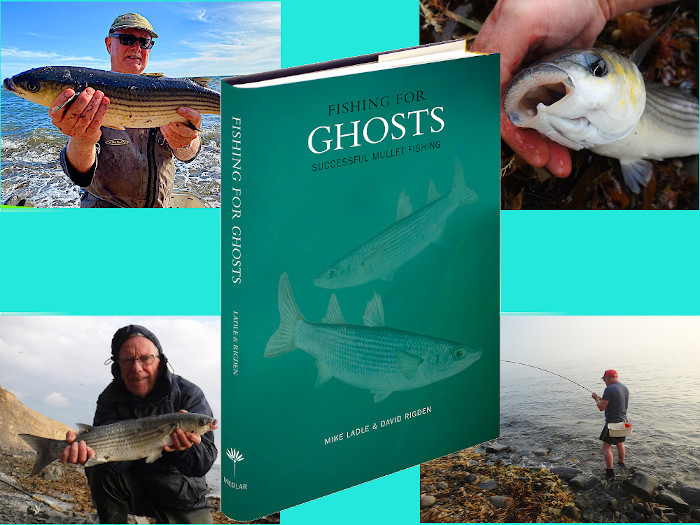
Written with David Rigden. Copies from
If you have any comments or questions about fish, methods, tactics or 'what have you!' get in touch with me by sending an E-MAIL to - docladle@hotmail.com